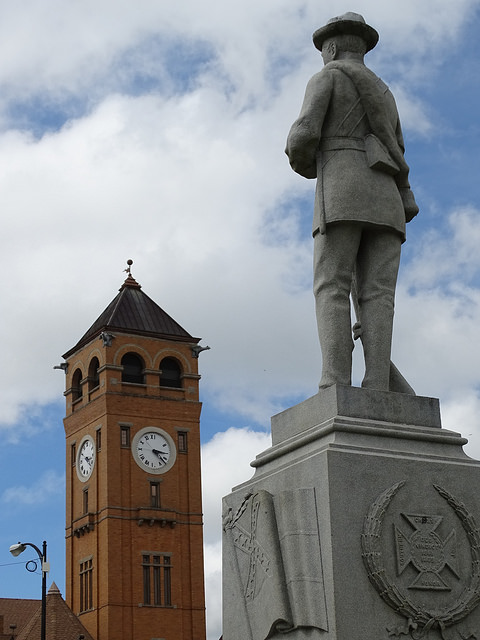
TUSKEGEE, Ala. — In 1906, when aging, white Confederate veterans of the Civil War and black ex-slaves still lived on the old plantations of the Deep South, two very different celebrations were afoot in this city known even then as a beacon of black empowerment.
Tuskegee Institute, founded to educate Southern blacks whose families had lived in bondage for generations, was saluting its 25th anniversary.
Meanwhile, area whites were preparing to dedicate a monument to rebel soldiers in a downtown park set aside exclusively for white people.
Flash forward to today and that same Confederate monument still stands in the same park, both owned by a Confederate heritage group. They sit in the heart of a poor, mostly black town of 9,800 people.
The story of how such a monument could remain in place a century later offers lessons in just how hard it can be to confront a shared history that still divides a nation.
In 1860, before the Civil War, Census records show 1,020 white people owned 18,176 black people in Macon County, where Tuskegee sits. Education became nearly as big a need as food and shelter once the fighting stopped.
Established by the Alabama Legislature, the Tuskegee Normal and Industrial Institute was founded in 1881, according to the school’s official history.
By the time of Tuskegee’s 25th anniversary, founder Booker T. Washington was widely acclaimed for advocating practical education, character building and hard work to lift blacks from poverty.
Coverage of the anniversary festivities in The Tuskegee News, a white-owned newspaper, emphasized that blacks needed to get along with the whites who had near total control in the old Confederate states.
Meanwhile, the United Daughters of the Confederacy, composed of female descendants of Confederate veterans, was erecting monuments glorifying the “lost cause” of the South across the region. The women of the Tuskegee chapter planned one for their town, holding events to raise money.
Two months after the Tuskegee Institute anniversary, leaders of the white-controlled county government gave the United Daughters the 2-acre, main downtown square to serve as a “park for white people” around a memorial to Macon County’s Confederate veterans, city records show.
The monument finally was dedicated on Oct. 6, 1909. The Montgomery Advertiser called the ceremony “one of the largest masses of white people ever before witnessed in Tuskegee.”
Newspaper stories from the time don’t say whether any blacks attended the event, but they most certainly were around. Macon County was around 82 per cent black then, Census records show, although Jim Crow laws kept whites in firm political control.
The nation’s first black combat pilots, the Tuskegee Airmen, trained in town in the 1940s, but not until the 1960s did the civil rights movement start changing political dynamics.
Frustrated after an all-white jury in another county acquitted a white man accused of murder in the shooting death of a civil rights worker, Samuel L. Younge Jr., blacks took out their anger on the Confederate monument in 1966.
On a night when rocks flew through windows around the town square, demonstrators identified in news accounts as Tuskegee students went after the Confederate monument, attaching a chain or rope to it.
“We didn’t have a vehicle to topple it that night and that’s why it’s still there,” said Simuel Schutz Jr., 72, a demonstrator who is now a contractor in Trenton, New Jersey.
But protesters did have spray paint. They painted a yellow stripe down the back of the stone soldier with the words “black power” scrawled on the base in black paint.
First elected mayor in 1972 but now out of office, Johnny Ford said he tried to have the monument relocated after taking office and again in 2015. Both efforts failed, as did a few similar attempts during the intervening years.
For some, the statue is just part of the city’s landscape and isn’t much of an issue.
“It’s just part of Tuskegee, part of its history,” said Kelvin Stephens, a black man who works in a computer shop near the memorial.
The United Daughters of the Confederacy still owns the square where the monument stands, and they don’t plan to remove it.
“It is a wonderful addition to the downtown area and has been there for over 100 years, and the United Daughters see no reason for it to change,” said a letter to the city by an attorney for the group, Richard L. Wyatt.
The few members still in town cleaned the statue after vandals tagged it with spray paint about three years ago, Wyatt said in an interview, but they’ve yet to remove black paint that stains the grey stone following a similar incident in October.
Mayor Lawrence F. Haygood Jr. has said he understands why some people want the statue gone, but there are no moves afoot to remove it as the one-year anniversary approaches of a deadly confrontation over a Confederate monument in Charlottesville, Virginia.
It’s unclear whether anything can be done anyway, since Alabama legislators passed a law last year banning the removal or alteration of sites including Confederate monuments like the one in Tuskegee.
“It’s just there in town like it’s always been,” said the mayor.